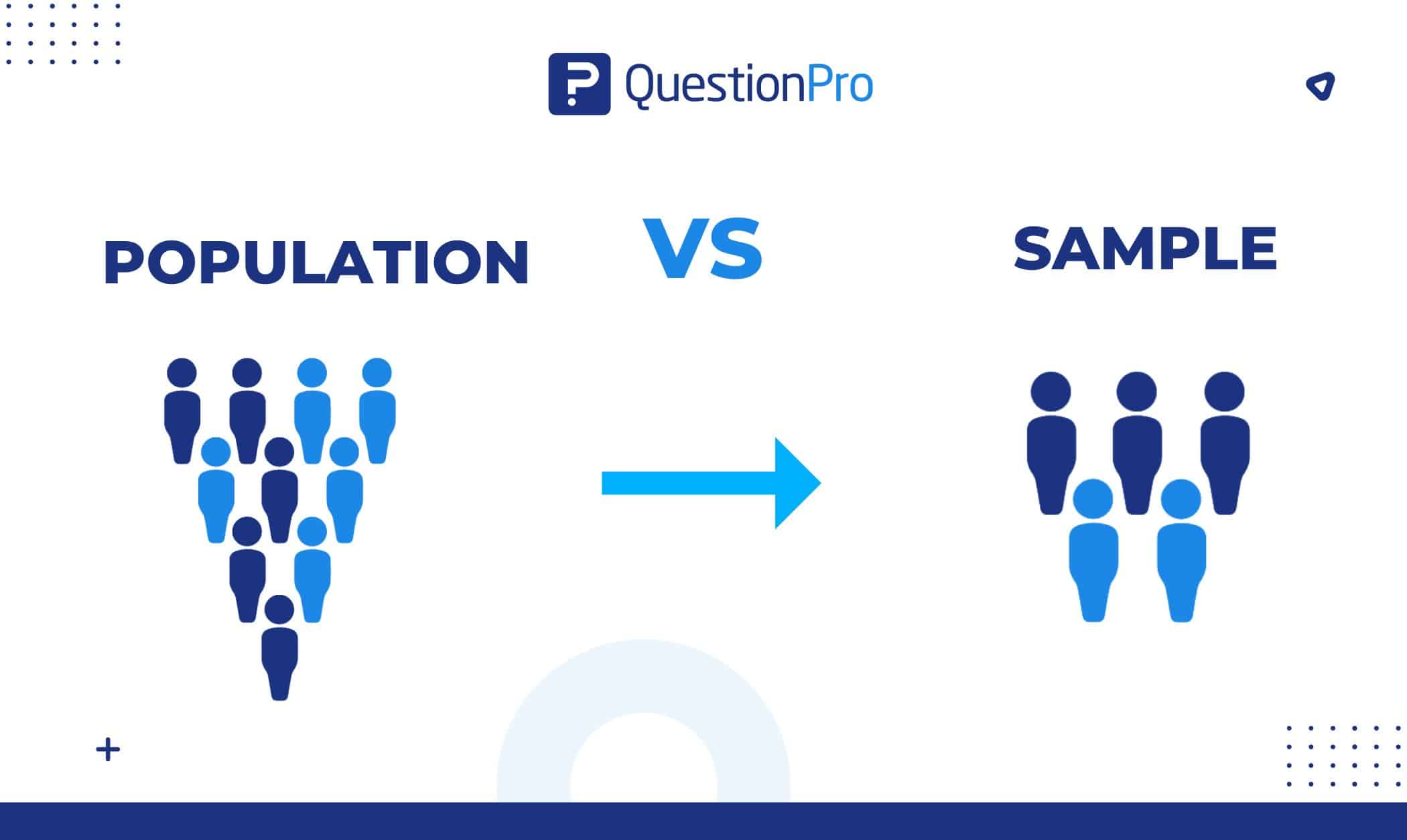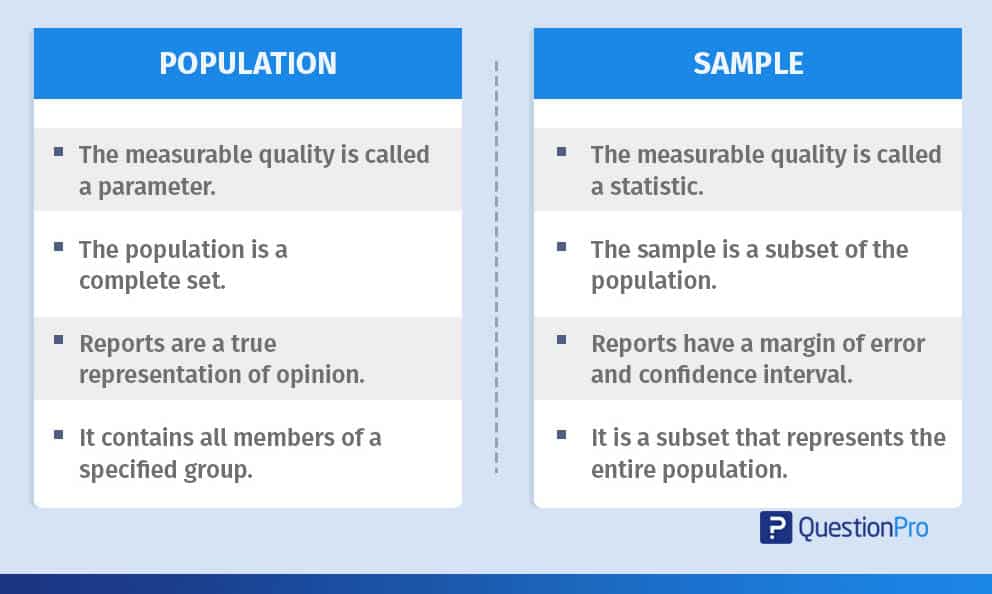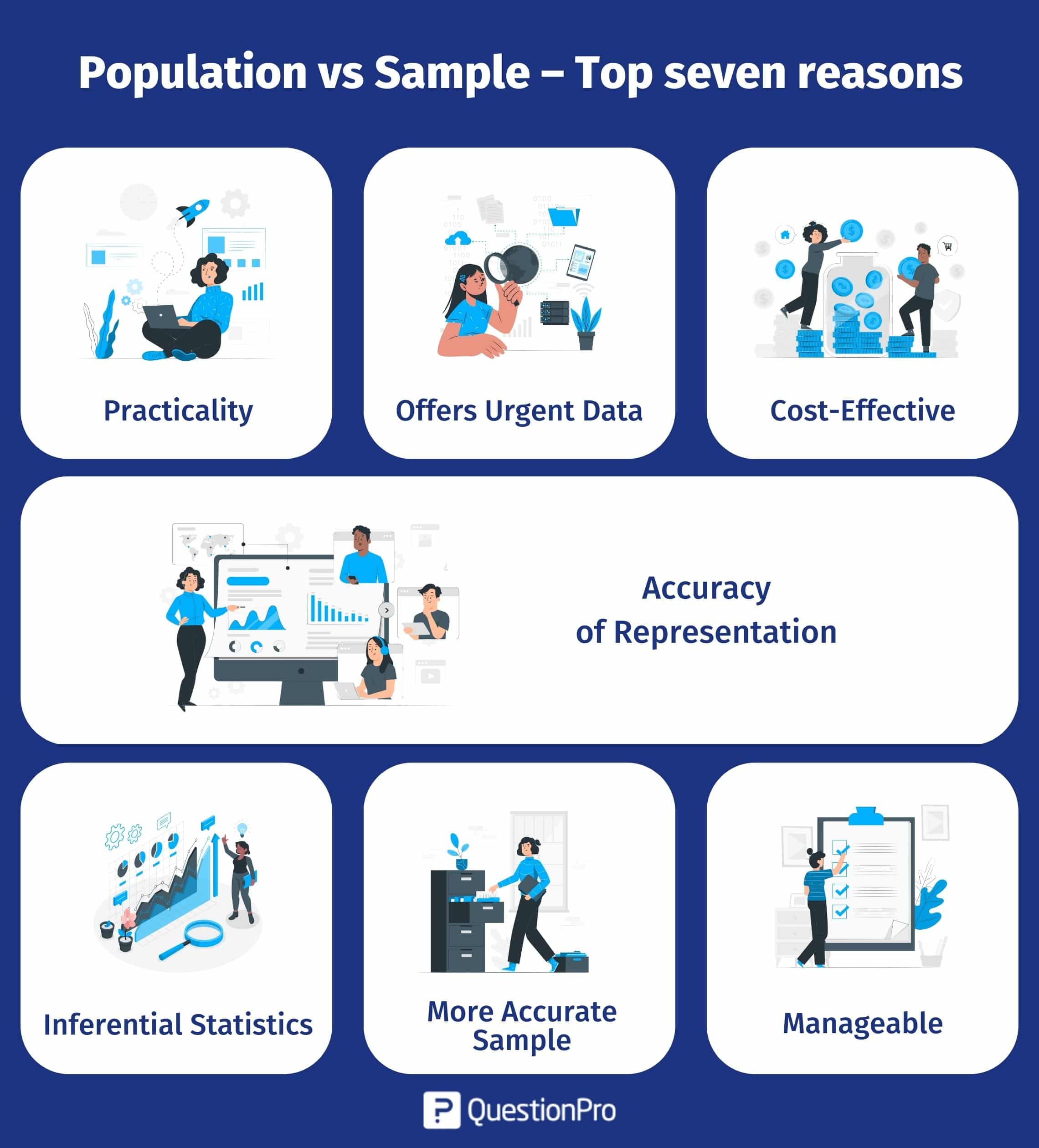
Imagine you’re conducting a survey on consumer preferences for your new product line, but interviewing every potential buyer would take forever. Here’s where two core concepts in research come in handy: population and sample.
These two concepts are often confused, although the difference is usually clear and easy to explain:
Think of the population as the universe of data points you could study. While a sample is like a snapshot of that universe, a smaller, manageable group represents the whole.
In this blog, we’ll break down the differences between population vs sample, explore when to use each, and provide insights into collecting accurate data to drive impactful research results.
What Does Population Mean in Research?
In research, a population is a complete set of elements with a standard parameter between them. We are all aware of what the word ‘population’ refers to daily. Frequently, it is used to describe the human population or the total number of people living in a geographic area of our country or state.
The ‘population’ in research doesn’t necessarily have to be human. It can be any parameter of data that possesses a common trait.
Example: The total number of ‘Pet’ Stores on Sunset Boulevard in Los Angeles, California.
Ways of Collecting Data from a Population
Gathering information from a whole population requires a census. A census is an assortment or collection of data from all segments of the population. It’s a finished identification of the populace and requires extensive assets, which is why specialists frequently work with an example.
However, you can collect data from every member of the population if the target population parameters are small.
For Example, conduct a performance evaluation of the bank branch’s customer service representatives. The number is probably going to be more reasonable, so you can access and gather information from this population.
When Is Data Collection From a Population Preferred?
Data collection from an entire population is typically preferred in specific scenarios where accuracy, completeness, and representation are critical. Here are some key instances:
- Small Population Size: When the target population is small, surveying every member is feasible, allowing complete, accurate data without needing sampling methods.
- High Precision Required: Full data collection reduces errors and provides a comprehensive view in cases where decisions based on the data have significant implications (e.g., healthcare studies, policy-making).
- Minimizing Sampling Bias: For research needing unbiased results, collecting data from the whole population eliminates sampling bias, as every member’s information is included.
- Homogeneous Populations: For studies involving highly uniform groups, collecting from the entire population can yield precise insights without variations that might affect a sample’s accuracy.
- Regulatory or Legal Requirements: In specific industries (e.g., census surveys or environmental studies), full population data collection is required to meet legal standards and provide national or state-level insights.
- Rare Populations: When studying rare populations where each member’s input is crucial for accurate insights, gathering data from the entire group is often necessary to represent characteristics accurately.
What is a Sample in Market Research?
A sample is a smaller part of the whole, i.e., a subset of the entire population. It is representative of the population in a study. When conducting surveys, the representative sample is the members of the population who are invited to participate.
Hence, a sample is a subgroup or subset within the population. This sample can be studied to investigate the characteristics or behavior of the entire population. Subgroup analysis is crucial for tailoring treatments to specific patient groups and optimizing healthcare outcomes.
Data samples are created using various research methods, such as probability and non-probability sampling. Sampling methods vary according to research types, based on the kind of inquiry and the quality of information required. Sampling error is harmful to sample data collection.
Example: A cat food company would like to know all the pet stores where it can sell its canned fish. The company has population data on the total number of pet stores on Sunset Boulevard.
This pet food manufacturer can now create an online research sample by only selecting the pet stores that sell cat food. The data characteristics are studied. The results are displayed in statistics and reports analyzed for business insights. Using data from the sample, the company can uncover ways to grow its business into the total population of pet stores.
Here are the Most Common Sampling Techniques
Sampling techniques are broadly classified into two types:
Probability sampling and non-probability sampling.
01. Probability sampling
Samples were chosen based on probability theory.
02. Non-probability sampling
Samples were chosen based on the researcher’s subjective judgment.
How to Choose High-Quality Samples
Although we ensure that all population members have an equal chance to be included in the sample, this does not mean that the samples derived from a particular population satisfying the criterion will be alike. They will still vary from one another, and this variation can be slight or substantial.
For example, a set of samples of healthy people’s body temperatures will show less difference. But the difference in these people’s systolic blood pressure would be sizeable.
It is also observed that the data’s accuracy depends on the sample size. The accuracy is much lower with a smaller sample size than with a larger study sample. Thus, if two, three, or more samples are derived from a population, the bigger they are, the more they resemble each other.
Population vs Sample – What is the Difference?
The concept of population vs sample is important for every researcher to comprehend.
Understanding the difference between a given population and a sample is easy. You must remember one fundamental law of statistics: A sample is always a smaller group (subset) within the population.
In market research and statistics, every study has an essential inquiry. Observation and experimentation of a population sample size determine this inquiry’s result. This is done to derive insights explaining a phenomenon within the study population.
Usually, a population sample is used in research, as it is easier and cost-effective to process a smaller subset of the population rather than the entire group.
In this table, we can take a closer look at the difference between the sample and population:

Examples to Better Understand the Concepts of Population vs Sample
To clarify the concepts of population vs sample, consider that a population includes every item or individual relevant to a study, while a sample represents a smaller group drawn from the population to provide insights without examining the entire group. Below are examples illustrating these concepts across different scenarios:
| Population | Sample |
| All books in a library | 50 randomly selected books from the library to assess their genres |
| All smartphones available in the market | 100 smartphones chosen from various brands for a battery performance test |
| All movie theaters in a city | 10 movie theaters in the city selected to survey customer satisfaction |
| All plants in a botanical garden | 25 specific plant species were sampled to study growth rates over time |
| All flights departing from a major airport | 30 random flights departing from the airport in one day for on-time performance tracking |
Top Seven Reasons to Choose a Sample from a Given Population
Sampling is a must when conducting any research study. Here are the top seven reasons to use a sample:

1. Practicality
In most cases, a population can be too large to collect accurate data, which is not practical. However, samples allow researchers to collect data that can be analyzed to provide insights into the entire population. If sampled accordingly, samples offer a representation of the whole population.
2. Offers urgent data
When it comes to research, the amount of time available can be a defining factor. A sample provides a smaller set of the population for review, delivering data useful to represent the whole population. Surveying a smaller sample, as opposed to the entire population, can save precious time for researchers and offer urgent data.
3. Cost-effective
The cost of conducting research is often a parameter for the study. Researchers must do their best with their resources to conduct a survey and gain accurate insights. Surveying a representative population sample is cost-effective as it requires fewer resources – like
- Computers,
- Researchers,
- Interviewers,
- Servers and
- Data collection centers.
4. Accuracy of representation
Depending on the sampling method, research conducted on a sample can be accurate with lesser non-response bias than if performed by the census. A sample that is selected using the non-probability method is an accurate representation of the population. This data collected can be used to gather insight into the whole community.
5. Inferential statistics
Inferential statistics is a process by which representative data is used to infer insights about the entire population. Inferential statistics can only be obtained using data samples; such statistical methods are also available. Data collected from a sample represents the whole population.
6. A sample is more accurate than a census
A census of an entire population only sometimes offers accurate data due to errors such as inconsistent responses or non-response bias. A carefully obtained sample, however, does away with this sampling bias and provides more accurate data – that adequately represents the population.
7. Manageable
Sometimes, collecting an entire data population is near impossible as some populations are too challenging. In this case, a sample can represent the study as
- Feasible,
- Manageable and
- Accessible.
Conclusion
Although Population and Sample are two different terms, they are related. The population is used to draw samples. The primary purpose of the sample is to make statistical inferences about the population. Without the population, samples can’t exist. The better the quality of the sample, the higher the level of generalization accuracy.
When using QuestionPro or any other survey tool for research, knowing the difference between population vs sample is essential. A sample is a subset of the studied population, while a population is the entire group of people or things that a researcher wants to study.
While planning a review utilizing QuestionPro, it is critical to painstakingly consider the objective populace and select a delegate test that precisely mirrors the qualities of the bigger populace. By doing this, researchers can ensure that their survey results are accurate and can be applied to the population.
Understanding the fundamental standards of examination and the populace can assist specialists in avoiding normal predispositions and entanglements that can make them question the precision of their examination discoveries.
When combined with a solid understanding of population and sampling, using QuestionPro can produce high-quality research results that can be used to make well-informed choices in various fields.
Right sampling is essential to conduct insightful market research. Explore quality samples with QuestionPro Audience.
Frequently Asked Questions (FAQs)
A: A population includes all individuals or items of interest, while a sample is a subset of the population used to make inferences about the entire group.
A: A sample example is surveying 100 students from a university to represent the opinions of all students there.
A: Samples are used more often because they are less costly, quicker to collect, and provide reliable insights about the population.
A: Use a population when feasible to study everyone or everything and a sample when resources or time are limited, and a representative subset will suffice.







